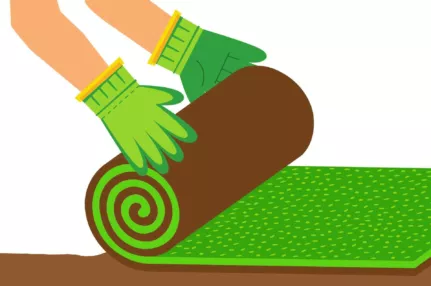Preparing your Turf for Spring

Now that the warmer climates of March and April are on their way, you may be wondering what the next steps are to ensure your turf bounces back following its winter dormancy period.
Garden Preparation
Your first step to preparing your garden for spring is to clear any winter debris that may remain like leaves, twigs and stones. Rake these off the lawn and remove any weeds that may have arisen over winter. You can do this with chemical-based weed killers or popular eco friendly DIY weed killers
like vinegar, lemon juice or boiling water.
Once your lawn has been cleared, you can then turn your attention to your soil.
Firstly, make sure that the ground isn’t frozen and that the springtime climate is appropriate for groundwork- moderate temperatures of around 10-15 °C are ideal.
If your ground has struggled with drainage over winter and you’ve seen water pooling in certain areas, you may want to aerate the soil. You can do this by poking holes in the ground with a garden fork to encourage proper drainage. It will also help air, water and nutrients to reach the roots more effectively.
Fertilisation
Early spring is the perfect time to fertilise as it gives your soil a boost before the turf starts actively growing.
When adding fertiliser to the ground, the soil nutrients will increase, giving the turf a stable and nourishing base ready for the growing season of later spring/early summer.
A well-fertilised & maintained lawn can also combat the spread and growth of weeds in Spring, making sure your turf stays healthy for longer.
You should be wary of over fertilising or fertilising in hotter temperatures as this can negatively affect the PH balance of the soil and potentially burn areas of the lawn. You may want to PH test your soil to see if it needs fertilising first.


Overseeding
If areas of your lawn have become patchy or brown over winter, you can overseed these areas to inspire re-growth.
Overseeding is best done in April for an optimal growth cycle. You should mow the lawn, sow the seed evenly over any damaged areas and then cover with a small amount of topsoil to ensure the seeds germinate into the ground.
You should see results in 2-3 weeks when conditions are optimal.
Our Rye Gold lawn seed is the same mix as our turf, and can blend into pre-existing lawns with ease.
Mowing
Wait until the lawn is dry enough to mow and position your mower blade to a high setting. You’ll want to make sure that, for it’s first mow after winter, you’re not cutting the lawn too short.
Scalping the lawn will stress the grass and can leave brown or bare patches in the lawn. You should never take more than one third of the length of the grass off at one time.
As you move into later spring & your turf continues to grow, the lawn will need mowing more frequently and you can gradually lower the height of your mower with each cut.


Laying Fresh Turf
If you’re looking to lay new turf this spring, you’ve chosen the perfect time to do it. The mild climate, sporadic rainfall and increased sunlight are all ideal conditions for turf to grow and thrive in, ensuring you a beautiful, lush lawn ready for the summer.
For more information on installing new turf this spring, you can follow our handy guides on how to lay turf, or purchase our top-quality Rye Gold turf now- available for next day delivery across the UK.


